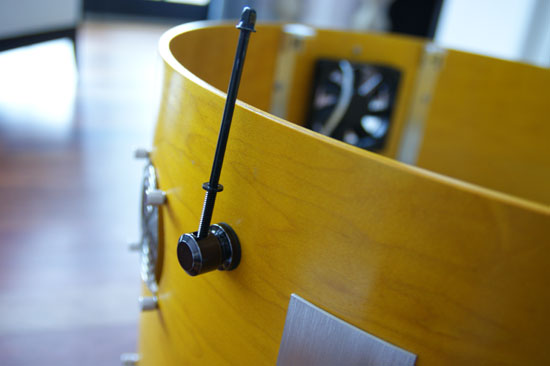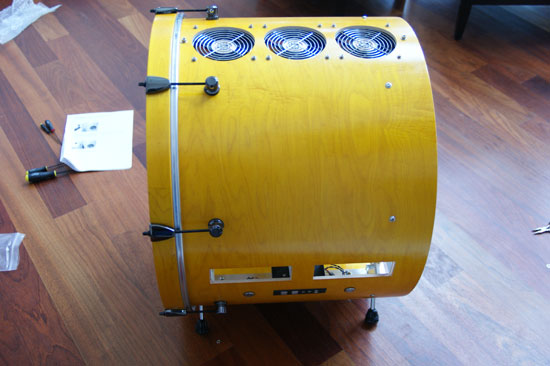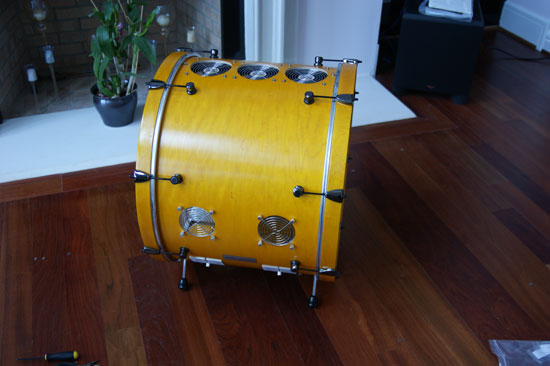Spotswood Custom Computer Cases
by Derek Wilson on August 27, 2008 12:00 AM EST- Posted in
- Cases/Cooling/PSUs
The L-24 Case
The hardware required to convert the C-24 to an L-24 is pictured here.

The process isn't difficult, but it is a little time consuming. First, remove the button screws around the outside of the case; then attach the lugs. Making sure they are vertical can be done by simply eyeballing things with a tension rod installed.

This isn't the most precise process, but we aren't actually building a musical instrument so we can sacrifice some of the accuracy we would otherwise want to maintain in putting this together. It's more about the way it looks in the end.


Going around one side and then the other, we attached all the lugs, set the drumheads on, and tightened down the rims. It actually really does look like a 24" kick drum. If you wanted to, just like with the C-24, you could have holes cut in the drumheads and mount fans in the sides of the case as well. Also, is it just me or is it a little odd to call the parts of this thing with the drumheads the sides?
















36 Comments
View All Comments
Spotswood - Wednesday, August 27, 2008 - link
As the President, builder and designer, I have a responsibility to clarify a few points in this review that are inaccurate, misrepresented or not at all addressed. I offer the following facts and information.- The two rear ports aren't meant for mounting case fans, rather they are there to access the inside of the case without having to remove a side panel/head.
- The hardware to convert the C-24 to an L-24 was provided to the author solely for the purpose of not having to supply two separate cases for review. An L-24 case normally has all of the hardware already attached to it.
- The mounting position of the motherboard tray is adjustable. The issues with the length of the PSU cables would have been eliminated if the author mounted the motherboard tray lower and more toward the front of the case. The instruction manual explicitly details the adjust-ability of the motherboard mounting.
- In the future, the motherboard tray will be revised with large holes to help facilitate routing cables from behind and underneath the motherboard itself.
- The case supplied for the review was built to have airflow move from the bottom to the top. However, when placing an order the customer is free to choose the total number of case fans (0-9), there location, along with the make and model.
- The three fans supplied with this particular case were SCYTHE S-FLEX™ 1200rpm fans (SFF21E). These fans are highly regarded by enthusiasts for there high CFM and low noise.
- The author failed to present any temperature or noise measurements prior to offering a series of solutions to perceived problems with cooling and noise.
- The case was built to be reviewed as a water-cooled case. A complete CPU water-cooling rig (D-Tek Fusion waterblock, Swiftech MCP655 pump, ThermoChill PA120.3 radiator, etc.) was supplied to the author for the sole purpose of this review.
Richard Chomiczewski, President
Spotswood Custom Computers, Inc.
cggkevin - Wednesday, August 27, 2008 - link
A better deal would be to go to a pawn shop and pick up a drum set for a couple of hundred and then just set a real PC case inside. This is kinda like a non-mini mini-ITC project.MagnumMan - Wednesday, August 27, 2008 - link
So basically they've tried to put a square peg in a round hole, on stands. Yuck.KIAman - Wednesday, August 27, 2008 - link
LOL, people have forgotten that style AND good performance should be considered in a case design.Drums? Come on, where's the creativity? I can brainstorm about 4 other designs without blinking.
1. Empty 5 gallon Aquafina jug
2. 1/8 scale model of Hummer
3. A 1 foot radius Earth globe
4. Toy model castle
mikeblas - Wednesday, August 27, 2008 - link
"(think oil rather than musical)"Are you sure? Because it looks way more like a musical drum than an oil drum, to me. And the review even says it's designed to look like a kick bass. Who edited this? Were they awake?
strikeback03 - Wednesday, August 27, 2008 - link
To me the article was not the most clear on the difference between C and L series cases, but as far as I could tell the C series are cylindrical but just have plain endcaps, not the drumheads and hardware. So sitting with the cylinder axis vertically and no bass drum hardware, it does sort of resemble a sawed-off oil barrel.Spacecomber - Wednesday, August 27, 2008 - link
I've always been skeptical about case designs, such as acrylic cases, that lack a metal exterior that can act as shield against the computer radiating electrical interference. This seems like it might be a particular concern in an environment where you are using analog audio equipment, such as in home theater, music server and music recording applications.While that's the theory, does anyone have some practical experience with regard to this potential problem?
wisfal - Wednesday, August 27, 2008 - link
I think that the style and uniqueness of the case is pretty good, I never thought of turning my drum kit into a computer case. I would go great for anyone with a music oriented room. But for a price like that, I could go to a pawn shop and Home Depot and build 10 of them for the price of one.Spivonious - Wednesday, August 27, 2008 - link
That is really cool! It reminds of the days when people were making cases out of chairs, tables, books, and anything else they could get their hands on. I imagine that it blends in nicely with the other instruments in your dining room.ChrisPL - Wednesday, August 27, 2008 - link
These "cases" are the most retarded thing I've ever seen... Waiting for a case made on a basis of refrigerator chasis...